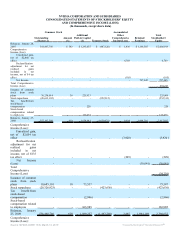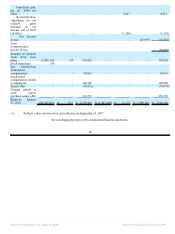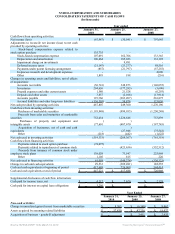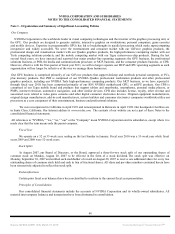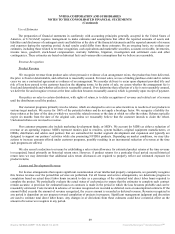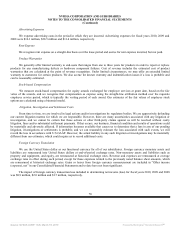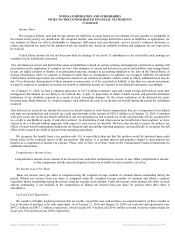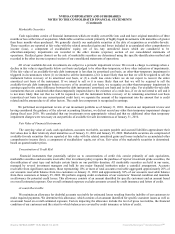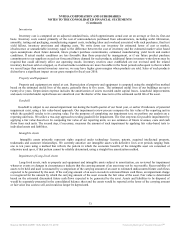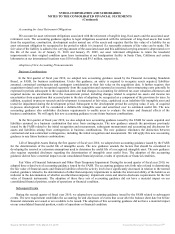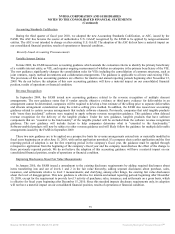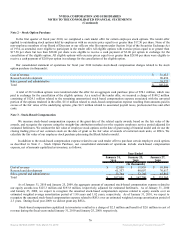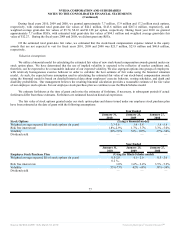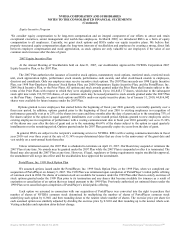NVIDIA 2010 Annual Report Download - page 91
Download and view the complete annual report
Please find page 91 of the 2010 NVIDIA annual report below. You can navigate through the pages in the report by either clicking on the pages listed below, or by using the keyword search tool below to find specific information within the annual report.
NVIDIA CORPORATION AND SUBSIDIARIES
NOTES TO THE CONSOLIDATED FINANCIAL STATEMENTS
(Continued)
Marketable Securities
Cash equivalents consist of financial instruments which are readily convertible into cash and have original maturities of three
months or less at the time of acquisition. Marketable securities consist primarily of highly liquid investments with maturities of greater
than three months when purchased. We generally classify our marketable securities at the date of acquisition as available-for-sale.
These securities are reported at fair value with the related unrealized gains and losses included in accumulated other comprehensive
income (loss), a component of stockholders’ equity, net of tax. Any unrealized losses which are considered to be
other-than-temporary impairments are recorded in the other income (expense) section of our consolidated statements of
operations. Realized gains (losses) on the sale of marketable securities are determined using the specific-identification method and
recorded in the other income (expense) section of our consolidated statements of operations.
All of our available-for-sale investments are subject to a periodic impairment review. We record a charge to earnings when a
decline in fair value is significantly below cost basis and judged to be other-than-temporary, or have other indicators of impairments.
If the fair value of an available-for-sale debt instrument is less than its amortized cost basis, an other-than-temporary impairment is
triggered in circumstances where (1) we intend to sell the instrument, (2) it is more likely than not that we will be required to sell the
instrument before recovery of its amortized cost basis, or (3) a credit loss exists where we do not expect to recover the entire
amortized cost basis of the instrument. If we intend to sell or it is more likely than not that we will be required to sell the
available-for-sale debt instrument before recovery of its amortized cost basis, we recognize an other-than-temporary impairment in
earnings equal to the entire difference between the debt instruments’ amortized cost basis and its fair value. For available-for-sale debt
instruments that are considered other-than-temporarily impaired due to the existence of a credit loss, if we do not intend to sell and it
is not more likely than not that we will be required to sell the instrument before recovery of its remaining amortized cost basis
(amortized cost basis less any current-period credit loss), we separate the amount of the impairment into the amount that is credit
related and the amount due to all other factors. The credit loss component is recognized in earnings.
We performed an impairment review of our investment portfolio as of January 31, 2010. Based on our impairment review and
having considered the guidance of the relevant accounting literature, we did not record any other than temporary impairment charges
during fiscal year 2010. We concluded that our investments were appropriately valued and that no additional other than temporary
impairment charges were necessary on our portfolio of available for sale investments as of January 31, 2010.
Fair Value of Financial Instruments
The carrying value of cash, cash equivalents, accounts receivable, accounts payable and accrued liabilities approximate their
fair values due to their relatively short maturities as of January 31, 2010 and January 25, 2009. Marketable securities are comprised of
available-for-sale securities that are reported at fair value with the related unrealized gains and losses included in accumulated other
comprehensive income (loss), a component of stockholders’ equity, net of tax. Fair value of the marketable securities is determined
based on quoted market prices.
Concentration of Credit Risk
Financial instruments that potentially subject us to concentrations of credit risk consist primarily of cash equivalents,
marketable securities and accounts receivable. Our investment policy requires the purchase of top-tier investment grade securities, the
diversification of asset type and includes certain limits on our portfolio duration. All marketable securities are held in our name,
managed by several investment managers and held by one major financial institution under a custodial arrangement. Accounts
receivable from significant customers, those representing 10% or more of total accounts receivable aggregated approximately 20% of
our accounts receivable balance from two customers at January 31, 2010 and approximately 38% of our accounts receivable balance
from three customers at January 25, 2009. We perform ongoing credit evaluations of our customers’ financial condition and maintain
an allowance for potential credit losses. This allowance consists of an amount identified for specific customers and an amount based
on overall estimated exposure. Our overall estimated exposure excludes amounts covered by credit insurance and letters of credit.
Accounts Receivable
We maintain an allowance for doubtful accounts receivable for estimated losses resulting from the inability of our customers to
make required payments. We determine this allowance, which consists of an amount identified for specific customer issues as well as
an amount based on overall estimated exposure. Factors impacting the allowance include the level of gross receivables, the financial
condition of our customers and the extent to which balances are covered by credit insurance or letters of credit.
Source: NVIDIA CORP, 10-K, March 18, 2010 Powered by Morningstar® Document Research℠


